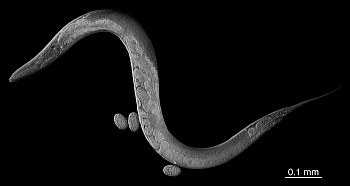main content Big Discoveries in Tiny Worms
Greg Hermann, professor of biology, has secured a $414,000 grant from the National Institutes of Health to unravel how the size of organelles impacts overall cell function in a worm model. This deep dive into the basic workings of cells may lead to future applications in medicine.
Faculty-Student Research

Professor of Biology Greg Hermann has secured a prestigious $414,000 R15 grant from the National Institutes of Health (NIH), funded by the National Institute of General Medical Sciences (NIGMS). The grant, awarded under the Academic Research Enhancement Award (AREA) program, supports Hermann’s ongoing research into cell biology, focusing on the architecture of organelles—specialized structures within cells.
The award is Hermann’s second from the National Institutes of Health, the largest public funder of biomedical research in the world, and his 13th external research grant since joining Lewis & Clark in 2002.
“This funding will allow us to further explore how organelles regulate their size, which is crucial to understanding overall cell function,” Hermann explains. “Although we know a lot about organelle function, we still have much to learn about how they control their size. Our team recently identified genes that play key roles in this process, and this grant will help us investigate how those genes function.”
A Model Organism: The Mighty C. elegans

Approximately half of C. elegans genes have similar counterparts in humans, making it an invaluable tool for understanding fundamental biological processes. “The worm’s predictable cell divisions and mapped gene sequence make it an ideal model for studying basic cell mechanisms,” Hermann says. “There’s a lot already known about the worm, and most of it is readily accessible.”
Hermann notes that work using C. elegans has been awarded four Nobel Prizes in Medicine this century—the latest just this year to Victor Ambros and Gary Ruvkun for the discovery of microRNA and its role in post-transcriptional gene regulation.
A Deeper Understanding of Cell Function
Hermann’s project, titled “Investigating the Role of Lipid Metabolism in the Biogenesis of Lysosome-Related Organelles,” explores how the process of breaking down and producing fats (lipids) affects the formation of specialized cell structures called lysosome-related organelles. Understanding this could reveal how changes in fat production and breakdown impact overall cell health and function.
“The more we understand cell function, the better positioned we are to understand what causes human diseases and how to treat them,” Hermann notes. “This isn’t translational research aimed directly at treatment, but rather foundational research to help us extend our knowledge of the basic mechanisms that underlie cell function—work that can lead to unexpected applications in medicine.”
Opportunities for Undergraduate Research
A significant aspect of Hermann’s grant is its emphasis on undergraduate involvement. The NIH AREA program is designed to foster biomedical research experiences for students while enhancing research environments at smaller institutions. Hermann’s lab will offer opportunities for six undergraduates during the academic year and three full-time students each summer over the next three years.
Nearly all of the Hermann lab alumni have pursued careers in the sciences; notably, four have gone on to work with Nobel laureates.
Typically, each student is mentored for two to three years in the Hermann lab. “These students are crucial to our research,” says Hermann. “They’re in the lab doing the science, crunching the data, helping write publications, and presenting their discoveries at conferences. It’s work that’s typically reserved only for graduate students.”
Madeline Daniel BA ’24, who graduated with a degree in biology, now works as Hermann’s full-time research technician. As an undergraduate, she did research in his lab for three years, including three summers as part of the John S. Rogers Science Research Program. During that time, she had the opportunity to travel for research conferences, present her own work, network with other practicing scientists, and complete an intensive undergraduate thesis.
“Greg’s lab has been a life-changing experience,” says Daniel. “Greg has changed the way I think about science and experimental design. Working in his lab has made me a more careful and more confident scientist.”
Trent Nause BA ’26, a biochemistry and molecular biology major, is a current research student in Hermann’s lab. “I feel that working with Greg has fundamentally changed the way I think about science, research, and what it means to know something,” says Nause. “I think that Greg pushes us to understand and ‘own’ the research we are doing, and that he wants all of us in the lab to take away skills as to how to approach and conduct good science.”
The environment of the lab is also supportive. “Greg’s approach to working with his student researchers is highly educational, constructive, and fun,” says Myla Butzlaff BA ’26, a biology major and lab assistant. “Whenever I see Greg in the lab, he is extremely welcoming and quick to make us laugh, creating a family atmosphere. I think we all learn more when we are laughing together.”
Hermann’s approach has proved remarkably successful. Over the past decade, he has trained 50 undergraduate students in his lab, 26 of whom have been coauthors on research publications. Nearly all of the Hermann lab alumni have pursued careers in the sciences; notably, four have gone on to work with Nobel laureates.
“Our lab alumni have gone on to do incredible things,” says Hermann. “Their success post-graduation reflects the scientific, creative, and critical thinking skills they’ve developed here.”
More Stories

Textual Treasures
Paging Through the Past
In her Medieval Manuscripts course, Professor of English Karen Gross brings history to life with the help of Watzek Library’s rich archival collections. Students get hands-on experience with centuries-old texts as they explore the art of archival research.

Dance Moves
NYC-Based Dance Company In Step With L&C Students
The Tiffany Mills Dance Company, named for and headed by L&C’s director of dance, took part in a spring residency on campus, leading a series of community dance workshops and performing The Viola Trilogy alongside students.

Groundbreaking Science
A Quantum Leap for Physics Students
Ben Olsen, assistant professor of physics, is establishing Lewis & Clark’s first Quantum Information Science and Engineering lab to probe how unusual types of matter behave at the subatomic level. But first he and his students have to build “The Apparatus.”

Immersive Learning
Voices of Vietnamese Portland
Nhân Hàn BA ’27 and Thoan Nguyễn BA ’27, with project manager Zoë Maughan BA ’19, curated a 15-panel, bilingual traveling exhibit highlighting stories from Vietnamese Portland: Memory, History, Community, an archive documenting experiences of Vietnamese Portlanders.
